The Study of the Wrinkles of Hexagonal Boron-Nitride Flake after the Annealing
Abstract
:1. Introduction
2. Materials and Methods
2.1. Sample Preparation
2.2. Annealing Experiment and Raman Spectra Measurement
2.3. AFM Characterization
2.4. Roughness Measurement
2.5. Molecular Dynamics Simulation
3. Results and Discussion
3.1. Thickness Measurement of Prepared
3.2. Morphology Variation after Each Annealing
3.3. Surface Roughness
3.4. Ex Situ and In Situ Raman Spectra
3.5. Crack Effect
4. Conclusions
Author Contributions
Funding
Data Availability Statement
Conflicts of Interest
References
- Geim, A.K.; Novoselov, K.S. The rise of graphene. Nat. Mater. 2007, 6, 183–191. [Google Scholar] [CrossRef]
- Wang, H.; Li, S.; Ai, R.; Huang, H.; Shao, L.; Wang, J. Plasmonically enabled two-dimensional material-based optoelectronic devices. Nanoscale 2020, 12, 8095–8108. [Google Scholar] [CrossRef]
- Rosso, C.; Filippini, G.; Criado, A.; Melchionna, M.; Fornasiero, P.; Prato, M. Metal-free photocatalysis: Two-dimensional nanomaterial connection toward advanced organic synthesis. ACS Nano 2021, 15, 3621–3630. [Google Scholar] [CrossRef] [PubMed]
- Jana, M.; Xu, R.; Cheng, X.B.; Yeon, J.S.; Park, J.M.; Huang, J.Q.; Zhang, Q.; Park, H.S. Rational design of two-dimensional nanomaterials for lithium—Sulfur batteries. Energy Environ. Sci. 2020, 13, 1049–1075. [Google Scholar] [CrossRef]
- Jing, X.; Li, Y.; Zhu, J.; Chang, L.; Maganti, S.; Naik, N.; Xu, B.B.; Murugadoss, V.; Huang, M.; Guo, Z. Improving thermal conductivity of polyethylene/polypropylene by styrene-ethylene-propylene-styrene wrapping hexagonal boron nitride at the phase interface. Adv. Compos. Hybrid Mater. 2022, 5, 1090–1099. [Google Scholar] [CrossRef]
- Mussa, Y.; Ahmed, F.; Arsalan, M.; Alsharaeh, E. Two dimensional (2D) reduced graphene oxide (RGO)/hexagonal boron nitride (h-BN) based nanocomposites as anodes for high temperature rechargeable lithium-ion batteries. Sci. Rep. 2020, 10, 1882. [Google Scholar] [CrossRef]
- Scardamaglia, M.; Boix, V.; D’Acunto, G.; Struzzi, C.; Reckinger, N.; Chen, X.; Shivayogimath, A.; Booth, T.; Knudsen, J. Comparative study of copper oxidation protection with graphene and hexagonal boron nitride. Carbon 2021, 171, 610–617. [Google Scholar] [CrossRef]
- Kulkarni, H.B.; Tambe, P.B.; Joshi, G.M. Influence of surfactant assisted exfoliation of hexagonal boron nitride nanosheets on mechanical, thermal and dielectric properties of epoxy Nanocomposites. Compos. Interfaces 2020, 27, 529–550. [Google Scholar] [CrossRef]
- Ren, W.; Ouyang, Y.; Jiang, P.; Yu, C.; He, J.; Chen, J. The impact of interlayer rotation on thermal transport across graphene/hexagonal boron nitride van der waals heterostructure. Nano Lett. 2021, 21, 2634–2641. [Google Scholar] [CrossRef]
- Li, F.; Zheng, Z.; Wang, X.; Li, H.; Yan, Y. Horizontally aligned BN nanosheet array for nanometer-thick ZrO2 coating with greatly enhanced anticorrosion and hydrogen isotope resistance property. Chem. Eng. J. 2022, 440, 135920. [Google Scholar] [CrossRef]
- Rathaur, A.S.; Katiyar, J.K.; Patel, V.K. Thermo-mechanical and tribological properties of SU-8/h-BN composite with SN150/perfluoropolyether filler. Friction 2020, 8, 151–163. [Google Scholar] [CrossRef]
- Du, X.Z.; Li, J.; Lin, J.Y.; Jiang, H.X. Temperature dependence of the energy bandgap of multi-layer hexagonal boron nitride. Appl. Phys. Lett. 2017, 111, 132106. [Google Scholar] [CrossRef]
- Oliveira, C.K.; Gomes, E.F.; Prado, M.C.; Alencar, T.V.; Nascimento, R.; Malard, L.M.; Batista, R.J.; de Oliveira, A.B.; Chacham, H.; de Paula, A.M.; et al. Crystal-oriented wrinkles with origami-type junctions in few-layer hexagonal boron nitride. Nano. Res. 2015, 8, 1680–1688. [Google Scholar] [CrossRef]
- Lim, H.; Jung, J.; Ruoff, R.S.; Kim, Y. Structurally driven one-dimensional electron confinement in sub-5-nm graphene nanowrinkles. Nat. Commun. 2015, 6, 8601. [Google Scholar] [CrossRef]
- Jiang, Y.; Mao, J.; Duan, J.; Lai, X.; Watanabe, K.; Taniguchi, T.; Andrei, E.Y. Visualizing strain-induced pseudomagnetic fields in graphene through an hBN magnifying glass. Nano Lett. 2017, 17, 2839–2843. [Google Scholar] [CrossRef] [PubMed]
- Levy, N.; Burke, S.A.; Meaker, K.L.; Panlasigui, M.; Zettl, A.; Guinea, F.; Castro Neto, A.H.; Crommie, M.F. Straininduced pseudo-magnetic fields greater than 300 tesla in graphene nanobubbles. Science 2010, 329, 544–547. [Google Scholar] [CrossRef] [PubMed]
- Meng, L.; Li, Y.; Liu, T.S.; Zhu, C.; Li, Q.Y.; Chen, X.; Zhang, S.; Zhang, X.; Bao, L.; Huang, Y.; et al. Wrinkle networks in exfoliated multilayer graphene and other layered materials. Carbon 2020, 156, 24–30. [Google Scholar] [CrossRef]
- Esfandiar, A.; Radha, B.; Wang, F.C.; Yang, Q.; Hu, S.; Garaj, S.; Nair, R.R.; Geim, A.K.; Gopinadhan, K. Size effect in ion transport through angstrom-scale slits. Science 2017, 358, 511–513. [Google Scholar] [CrossRef] [PubMed]
- Gopinadhan, K.; Hu, S.; Esfandiar, A.; Lozada-Hidalgo, M.; Wang, F.C.; Yang, Q.; Tyurnina, A.V.; Keerthi, A.; Radha, B.; Geim, A.K. Complete steric exclusion of ions and proton transport through confined monolayer water. Science 2019, 363, 145–148. [Google Scholar] [CrossRef]
- Fumagalli, L.; Esfandiar, A.; Fabregas, R.; Hu, S.; Ares, P.; Janardanan, A.; Yang, Q.; Radha, B.; Taniguchi, T.; Watanabe, K.; et al. Anomalously low dielectric constant of confined water. Science 2018, 360, 1339–1342. [Google Scholar] [CrossRef] [PubMed] [Green Version]
- Wang, Y.; Yang, R.; Shi, Z.; Zhang, L.; Shi, D.; Wang, E.; Zhang, G. Super-Elastic Graphene Ripples for Flexible Strain Sensors. ACS Nano 2011, 5, 3645–3650. [Google Scholar] [CrossRef] [PubMed]
- Chen, L.; Elibol, K.; Cai, H.; Jiang, C.; Shi, W.; Chen, C.; Wang, H.S.; Wang, X.; Mu, X.; Li, C.; et al. Direct observation of layer-stacking and oriented wrinkles in multilayer hexagonal boron nitride. 2D Mater. 2021, 8, 024001. [Google Scholar] [CrossRef]
- Nayyar, V.; Ravi-Chandar, K.; Huang, R. Stretch-induced wrinkling of polyethylene thin sheets: Experiments and modeling. Int. J. Solids Struct. 2014, 51, 1847–1858. [Google Scholar] [CrossRef]
- Yang, K.; Chen, Y.; Pan, F.; Wang, S.; Ma, Y.; Liu, Q. Buckling Behavior of Substrate Supported Graphene Sheets. Materials 2016, 9, 32. [Google Scholar] [CrossRef] [PubMed]
- Novoselov, K.S.; Jiang, D.; Schedin, F.; Booth, T.; Khotkevich, V.V.; Morozov, S. Two-dimensional atomic crystals. Proc. Natl. Acad. Sci. USA 2005, 102, 10451–10453. [Google Scholar] [CrossRef]
- Patel, D.R.; Kiran, M.B. A non-contact approach for surface roughness prediction in CNC turning using a linear regression model. Mater. Today Proc. 2020, 26, 350–355. [Google Scholar] [CrossRef]
- Maaravi, T.; Leven, I.; Azuri, I.; Kronik, L.; Hod, O. Interlayer Potential for Homogeneous Graphene and Hexagonal Boron Nitride Systems: Reparameterization for Many-Body Dispersion Effects. J. Phys. Chem. C 2017, 121, 22826–22835. [Google Scholar] [CrossRef]
- Sosa, E.B. Computational Study of the Development of Graphene Based Devices; Texas A&M University: College Station, TX, USA, 2012. [Google Scholar]
- Toupin, R.A. Saint-Venant’s principle. Arch. Ration. Mech. Anal. 1965, 18, 83–96. [Google Scholar] [CrossRef]
- Wagner, H.D.; Eitan, A. Stress concentration factors in two-dimensional composites: Effects of material and geometrical parameters. Compos. Sci. Technol. 1993, 46, 353–362. [Google Scholar] [CrossRef]
- Gong, L.; Kinloch, I.A.; Young, R.J. Interfacial stress transfer in a graphene monolayer nanocomposite. Adv. Mater. 2010, 22, 2694–2697. [Google Scholar] [CrossRef] [Green Version]
- Qu, W.; Chen, X.; Ke, C. Temperature-dependent frictional properties of ultra-thin boron nitride nanosheets. Appl. Phys. Lett. 2017, 110, 143110. [Google Scholar] [CrossRef]
- Young, R.J.; Gong, L.; Kinloch, I.A.; Riaz, I.; Jalil, R.; Novoselov, K.S. Strain mapping in a graphene monolayer nanocomposite. Acs. Nano 2011, 5, 3079–3084. [Google Scholar] [CrossRef]
- Liu, Z.; Song, L.; Zhao, S.; Huang, J.; Ma, L.; Zhang, J.; Lou, J.; Ajayan, P.M. Direct growth of graphene/hexagonal boron nitride stacked layers. Nano Lett. 2011, 11, 2032–2037. [Google Scholar] [CrossRef]
- Pinon, A.V.; Wierez-Kien, M.; Craciun, A.D.; Beyer, N.; Gallani, J.L.; Rastei, M.V. Thermal effects on van der Waals adhesive forces. Phys. Rev. B 2016, 93, 035424. [Google Scholar] [CrossRef]
- El-Kareh, B.; Hutter, L.N. Fundamentals of Semiconductor Processing Technology; Springer Science & Business Media: New York, NY, USA, 2012. [Google Scholar]
- Anees, P.; Valsakumar, M.C.; Panigrahi, B.K. Effect of strong phonon–phonon coupling on the temperature dependent structural stability and frequency shift of 2D hexagonal boron nitride. Phys. Chem. Chem. Phys. 2016, 18, 2672–2681. [Google Scholar] [CrossRef] [PubMed]

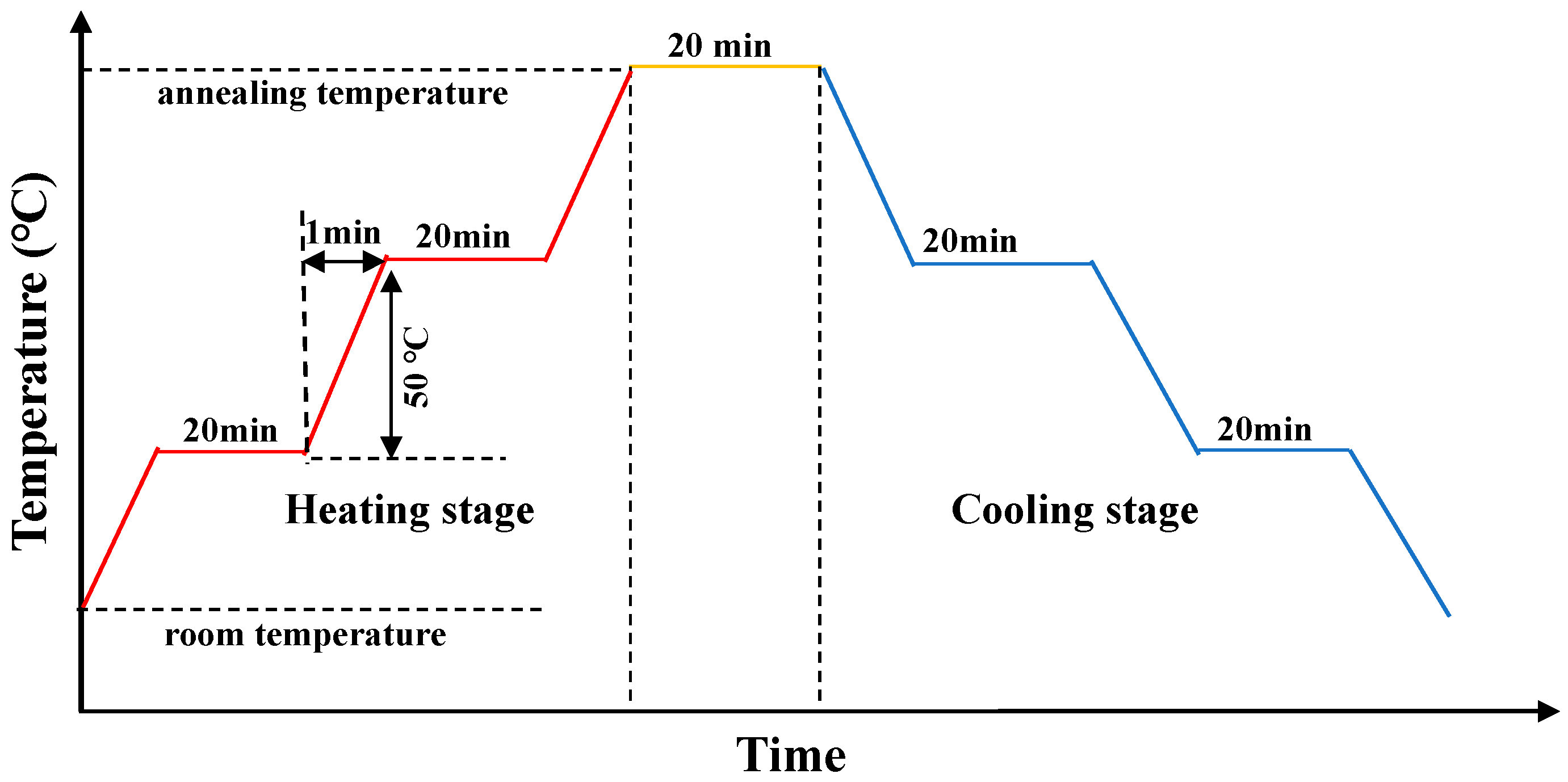



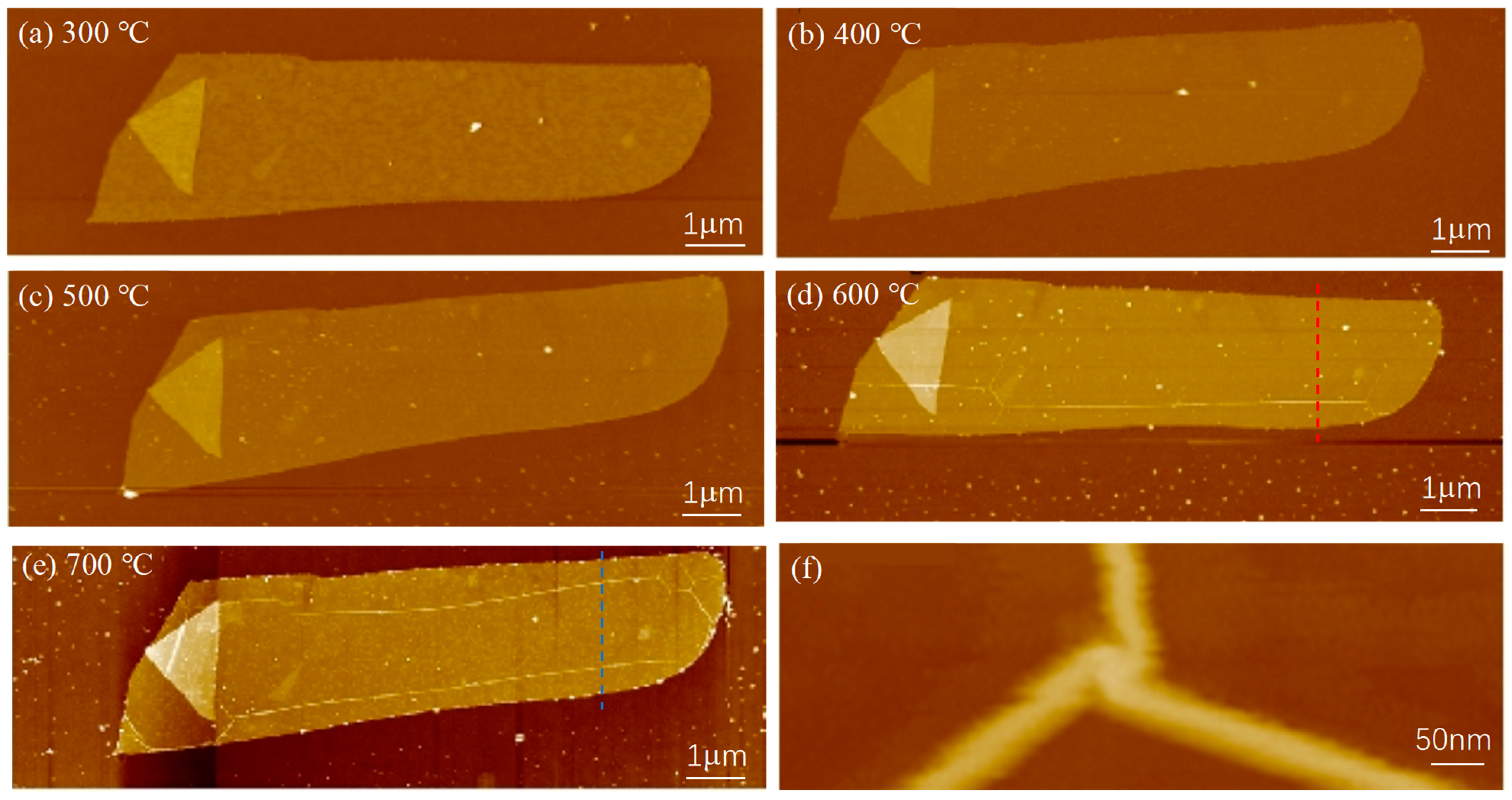
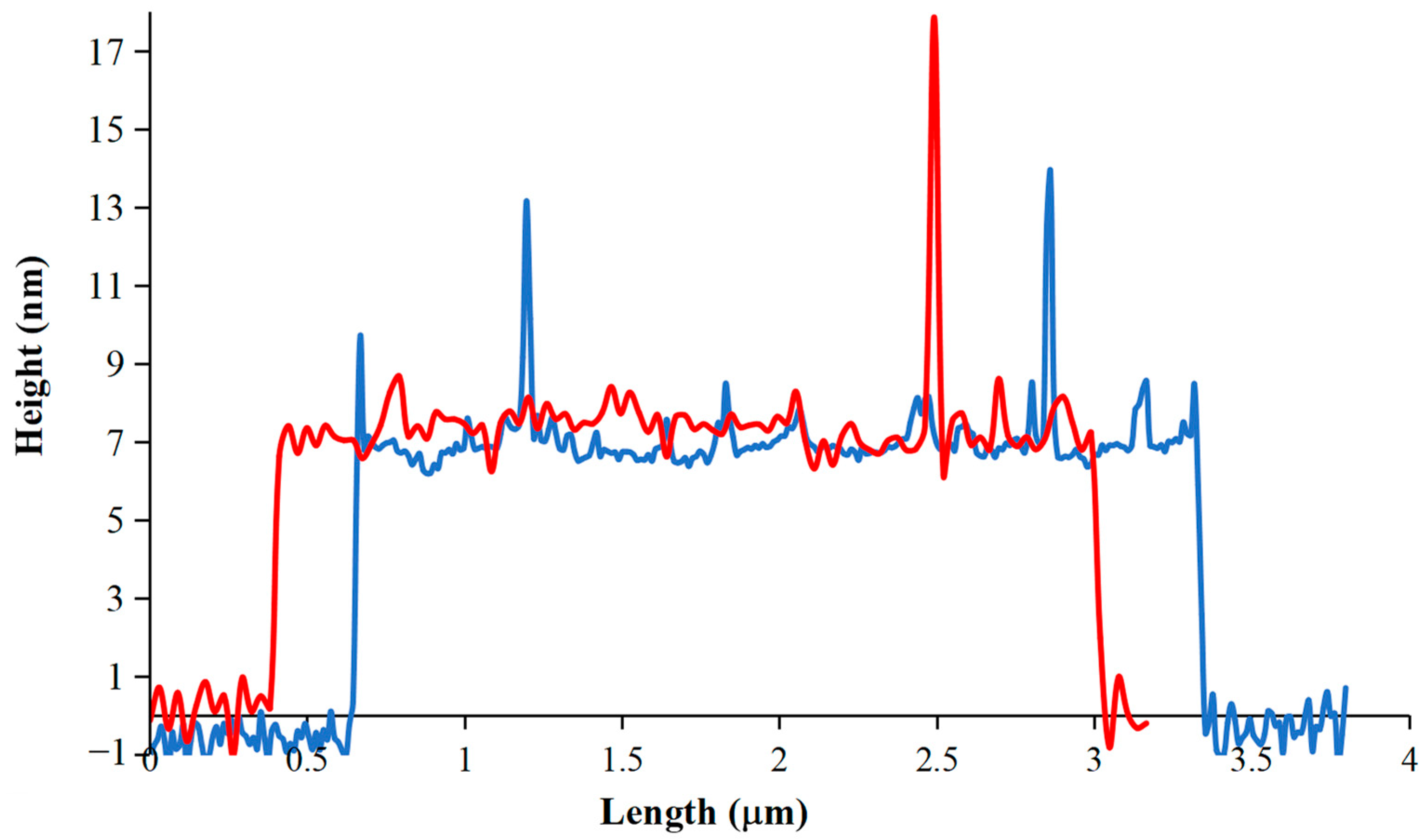
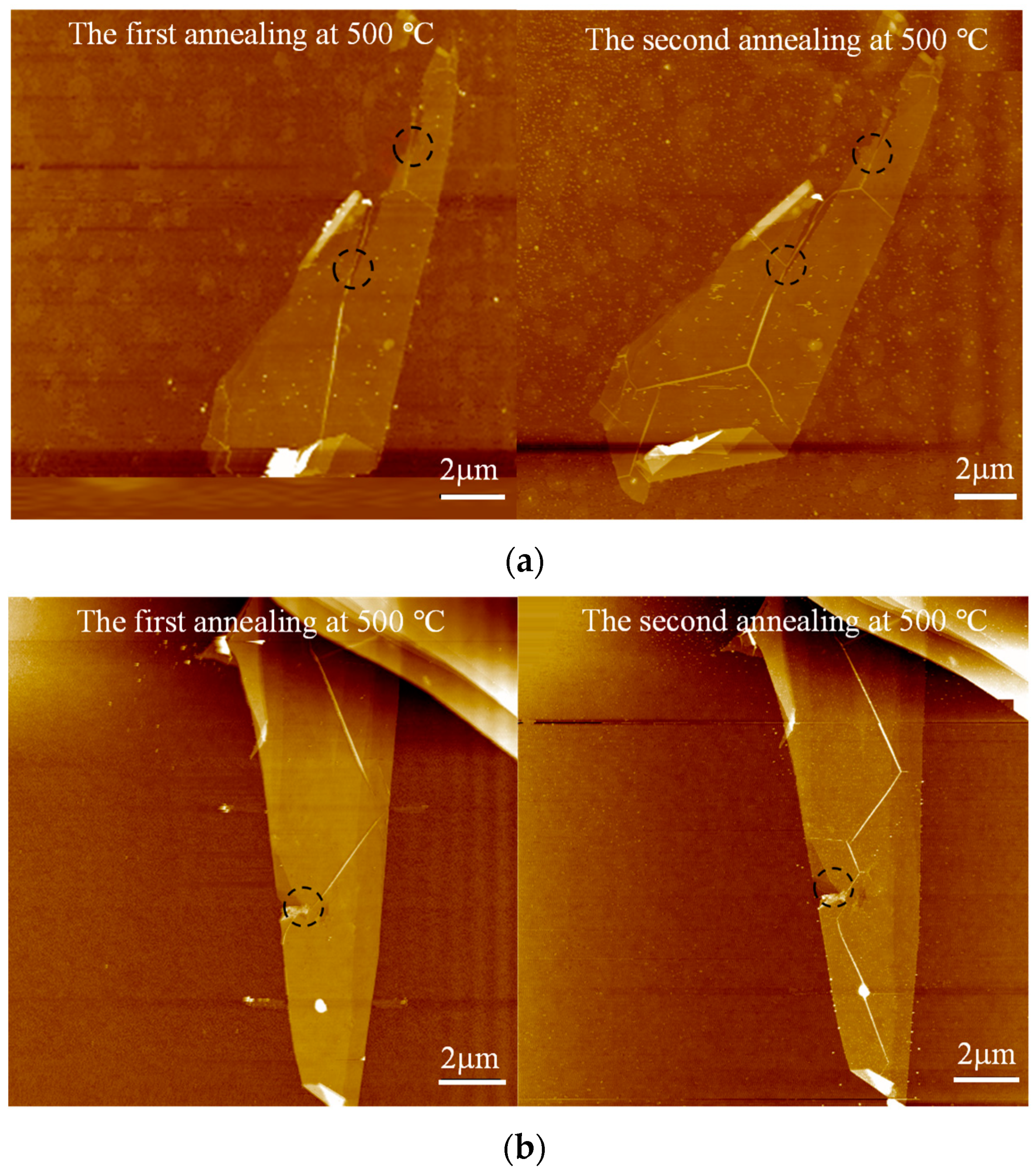
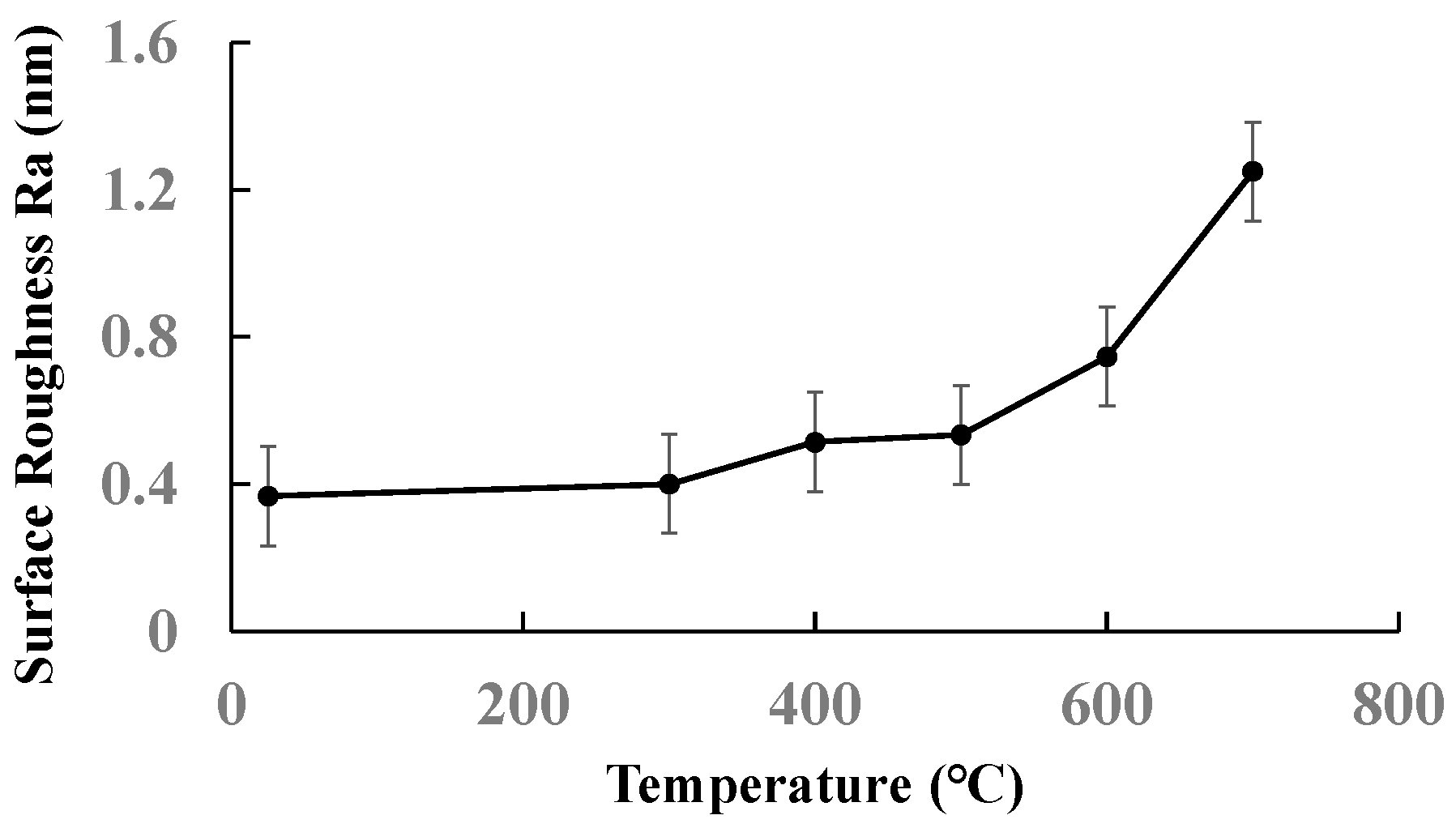
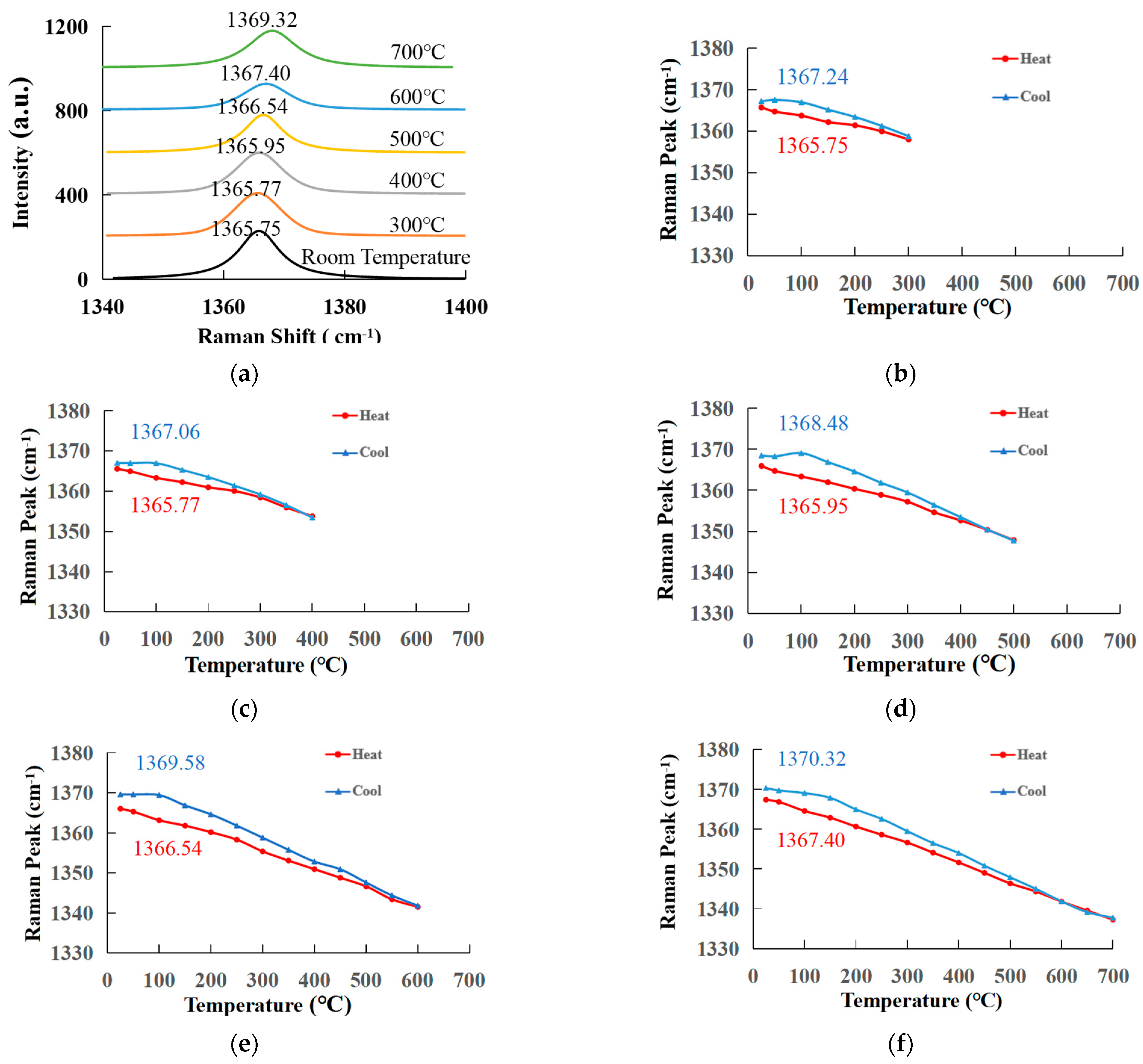
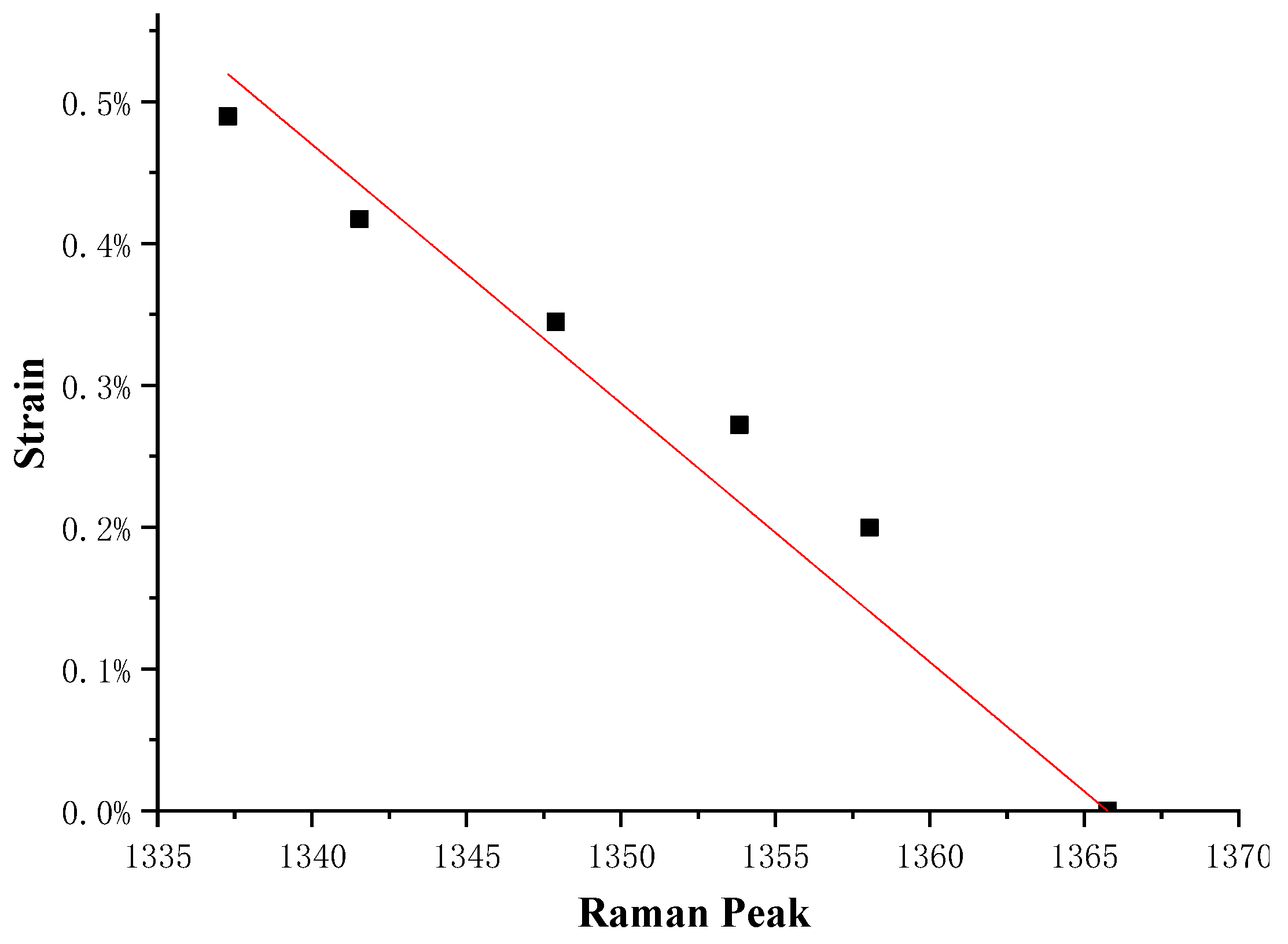
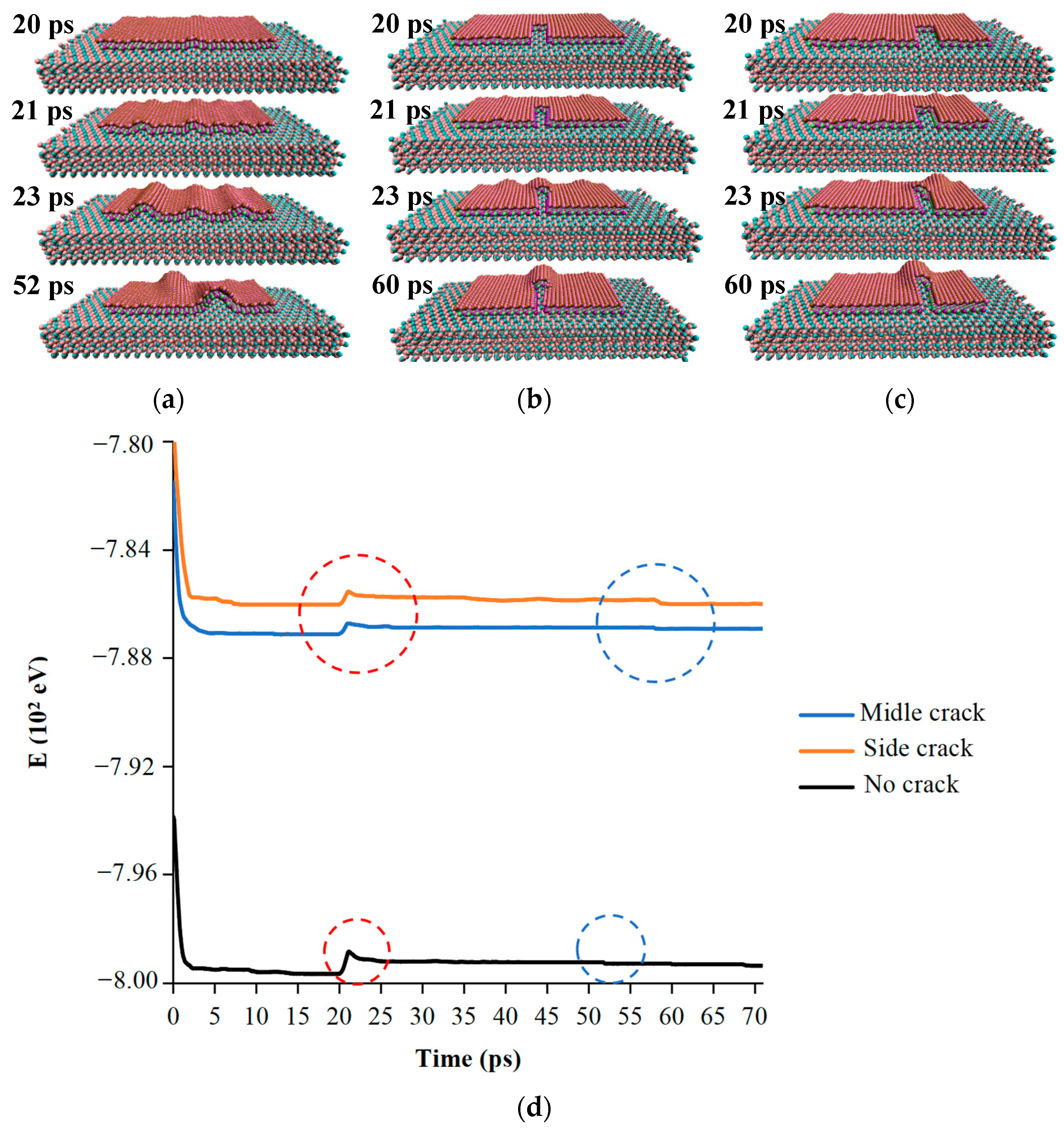

Disclaimer/Publisher’s Note: The statements, opinions and data contained in all publications are solely those of the individual author(s) and contributor(s) and not of MDPI and/or the editor(s). MDPI and/or the editor(s) disclaim responsibility for any injury to people or property resulting from any ideas, methods, instructions or products referred to in the content. |
© 2023 by the authors. Licensee MDPI, Basel, Switzerland. This article is an open access article distributed under the terms and conditions of the Creative Commons Attribution (CC BY) license (https://creativecommons.org/licenses/by/4.0/).
Share and Cite
Zhang, G.; Chang, Y.; Yan, B. The Study of the Wrinkles of Hexagonal Boron-Nitride Flake after the Annealing. Crystals 2023, 13, 304. https://doi.org/10.3390/cryst13020304
Zhang G, Chang Y, Yan B. The Study of the Wrinkles of Hexagonal Boron-Nitride Flake after the Annealing. Crystals. 2023; 13(2):304. https://doi.org/10.3390/cryst13020304
Chicago/Turabian StyleZhang, Guocheng, Yufang Chang, and Bin Yan. 2023. "The Study of the Wrinkles of Hexagonal Boron-Nitride Flake after the Annealing" Crystals 13, no. 2: 304. https://doi.org/10.3390/cryst13020304



